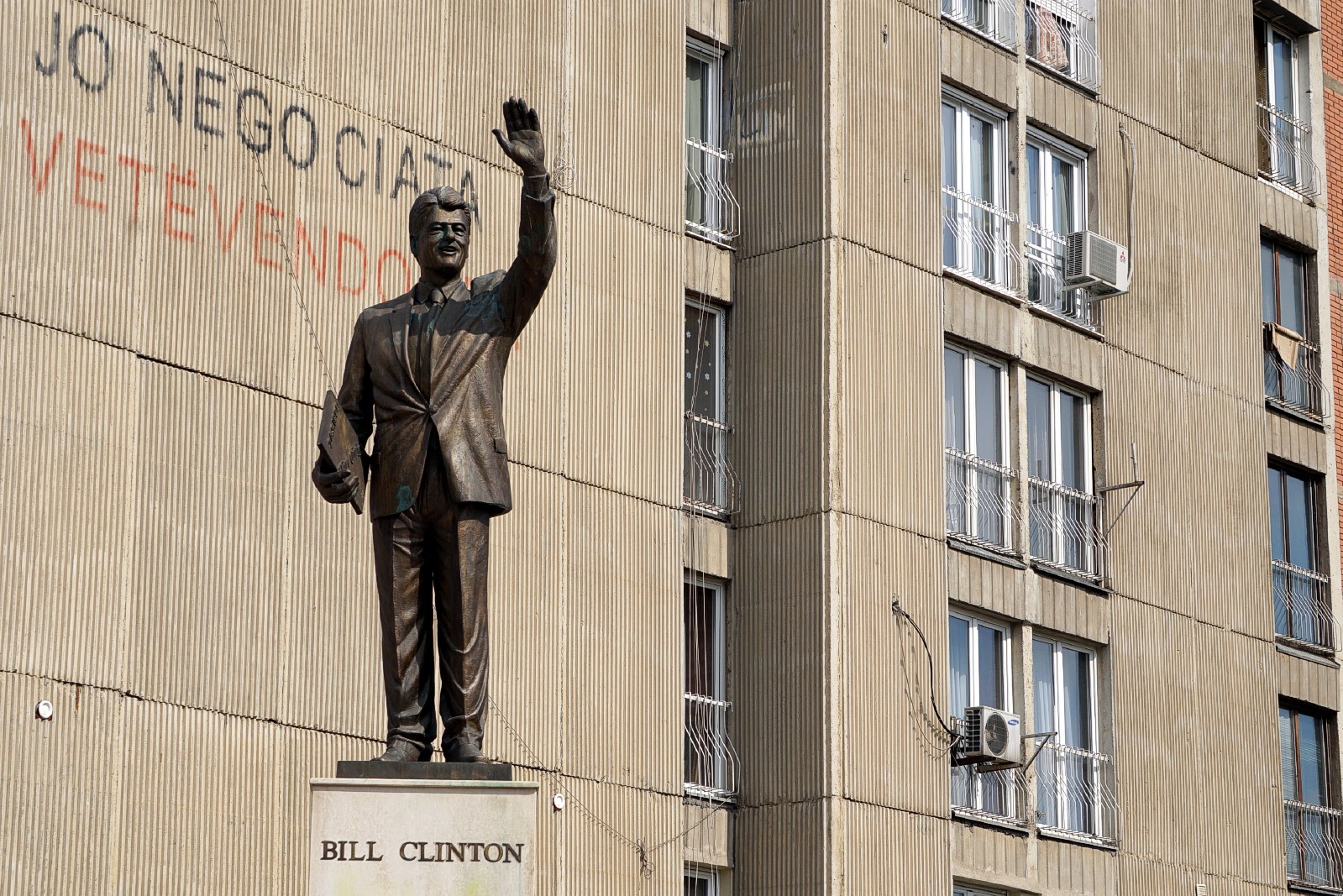Kosovo
A Curious Mix, The Balkans Very Own De Facto Independent CountryThe Bill Clinton Statue on Bill Clinton Boulevard, Pristina, Kosovo. April 22, 2017.
“It’s affordable, gritty, youthful, ambitious & friendly, a very new country dealing with a troubled past while looking towards a brighter future.”
Kosovo
A curious place is Kosovo, the central Balkans very own disputed territory and de facto independent country. It’s officially secular, yet religion is everywhere, has a long-standing tradition here and has shaped the country we see today. It uses the Euro, but isn’t in the EU. It’s affordable, gritty, youthful, ambitious & friendly, a very new country dealing with a troubled past while looking towards a brighter future. Here and now Kosovo also has bears, UNESCO-listed monuments and a likable capital city boasting 200,000+ hospitable locals, a not-so-old Old Quarter, a bizarre man crush on a former US president, life-size lettering (always good for a photo op), great street scenes, and some standout architecture, including what must surely be a contender for the ugliest building on earth. It’s a curious mix alright, but one that somehow works, so much so that in 2016 Rough Guides named it one of the 12 underrated destinations you absolutely have to visit.
So yes, Kosovo will win hearts.
It did mine.
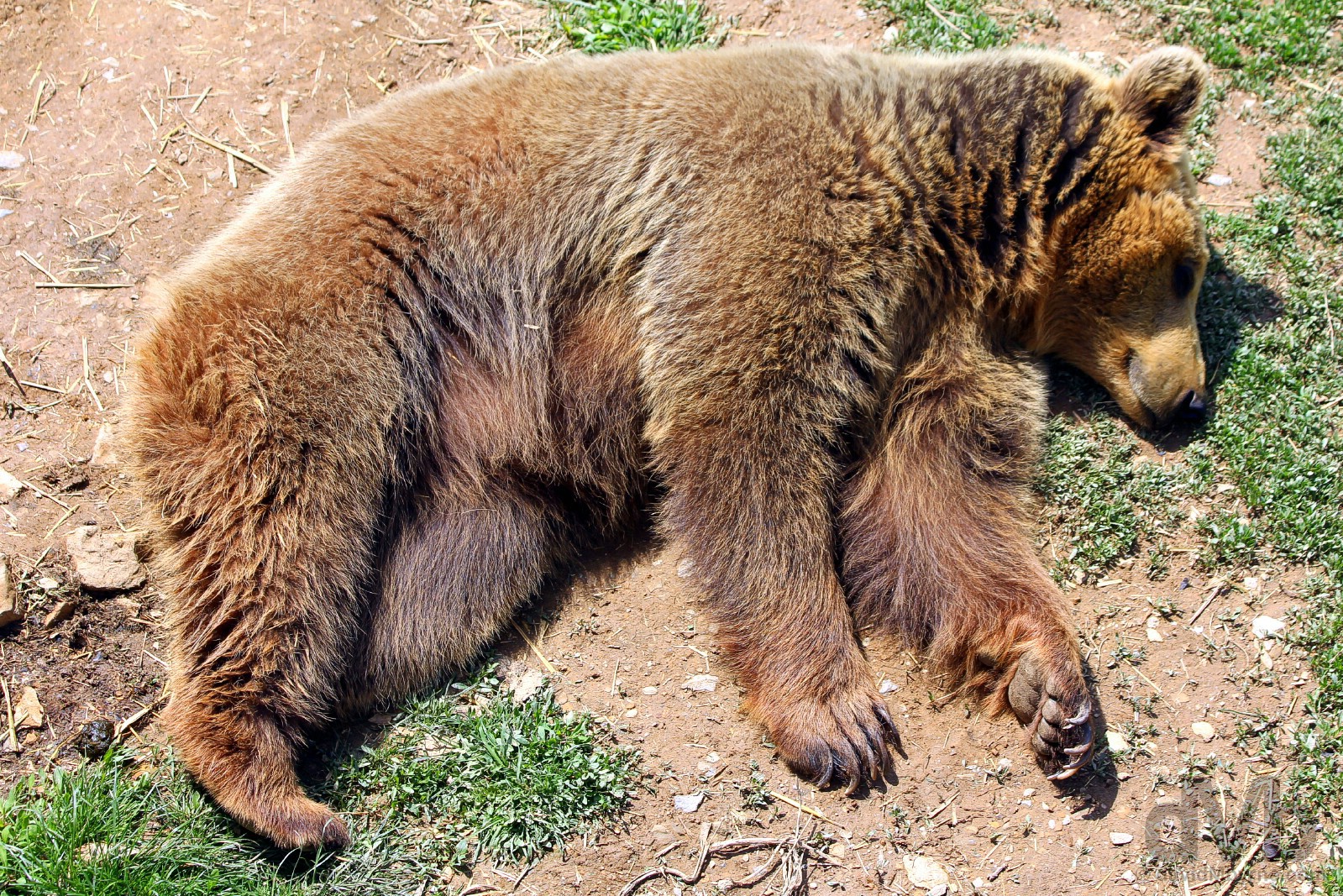
Resting up at the Bear Sanctuary Prishtina, Kosovo. April 22, 2017.
dMb Country Overview - (Republic of) Kosovo
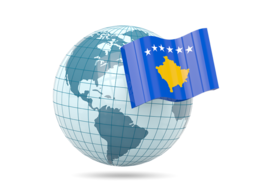 (Republic of) Kosovo
(Republic of) Kosovo
Region – Southeastern Europe/The Balkans (dMb tag: The Balkans). Capital – Pristina. Population – 2.1+ million Kosovars. Official Languages – Albanian, Serbian. Currency – Euro (€). GDP (nominal) per capita – US$4,000+. Political System – Unitary parliamentary constitutional republic. EU Member? – No. UN Member? – No (the Russians are having none of that). G20 Member? – No. Size – 10,900 km² (Europe’s 11th smallest country is approximately half the size of Slovenia & about the same size as the 2 smallest US states of Delaware & Rhode Island combined). Topography – Landlocked & with a largely mountainous perimeter enclosing 2 major plains. Climate – Continental with both Mediterranean and alpine influences – cold winters, hot summers. Brief History & Today – Part of the Ottoman Empire for over half a century (from 1389 until 1912), like most of the present-day Balkans, Kosovo was part of the old Yugoslavia from 1943 until 1992, and part of the then Union of Serbia and Montenegro (formed as a result of the 1992 breakup of Yugoslavia) until its peaceful dissolution in 2006. Although it declared independence from Serbia in February 2008, after a rather protracted & often violent struggle, Kosovo is still today officially disputed, although the country’s legitimacy is backed by the US and most industrialised nations – 113 of the 193 UN member states (as of September 2019), 24 of the 28 NATO states & 23 of the 38 EU member states, Spain being the only major Western European country not to recognise Kosovo (to do so could be seen as lending legitimacy to Catalonia’s cause, northeastern Spain’s very own wannabe independent region). Suffice it to say, Serbia still considers the country an upstart southern province as opposed to a separate sovereign state, while Russia, Serbia’s ally, will continue to use its veto as a permanent member of the UN Security Council to ensure Kosovo doesn’t become a member of the UN any day soon. UNESCO World Heritage sites – 1 (1 listing, 4 different sites). Tourism Catchphrase/Slogans – None that I could find. Famous For – Being disputed; being Europe’s newest country; beautiful women (Kosovo is one of the most successful entrants into the Miss Universe pageant). Highlights – Pristina, hiking & UNESCO-listed 13th-century monasteries. Kosovo Titbits – Over 90% of Kosovo’s population are ethnic Albanians with 95% of the population speaking Albanian as their first language; with a long history of conflicting Islamic & Orthodox Christianity influences and while today officially secular, over 95% of Kosovars are Muslim (according to the 2014 Freedom of Thought reports issued by the IHEU, Kosovo ranked first in the Southern Europe and ninth in the world as Free and equal for tolerance towards religion and atheism); Europe’s youngest country really is its youngest county – 70% of the population is under the age of 35.

RKS. A licence plate showing the Kosovo flag as seen on the streets of Pristina, Kosovo. April 22, 2017.
Visits – April 2017.
– Lonely Planet
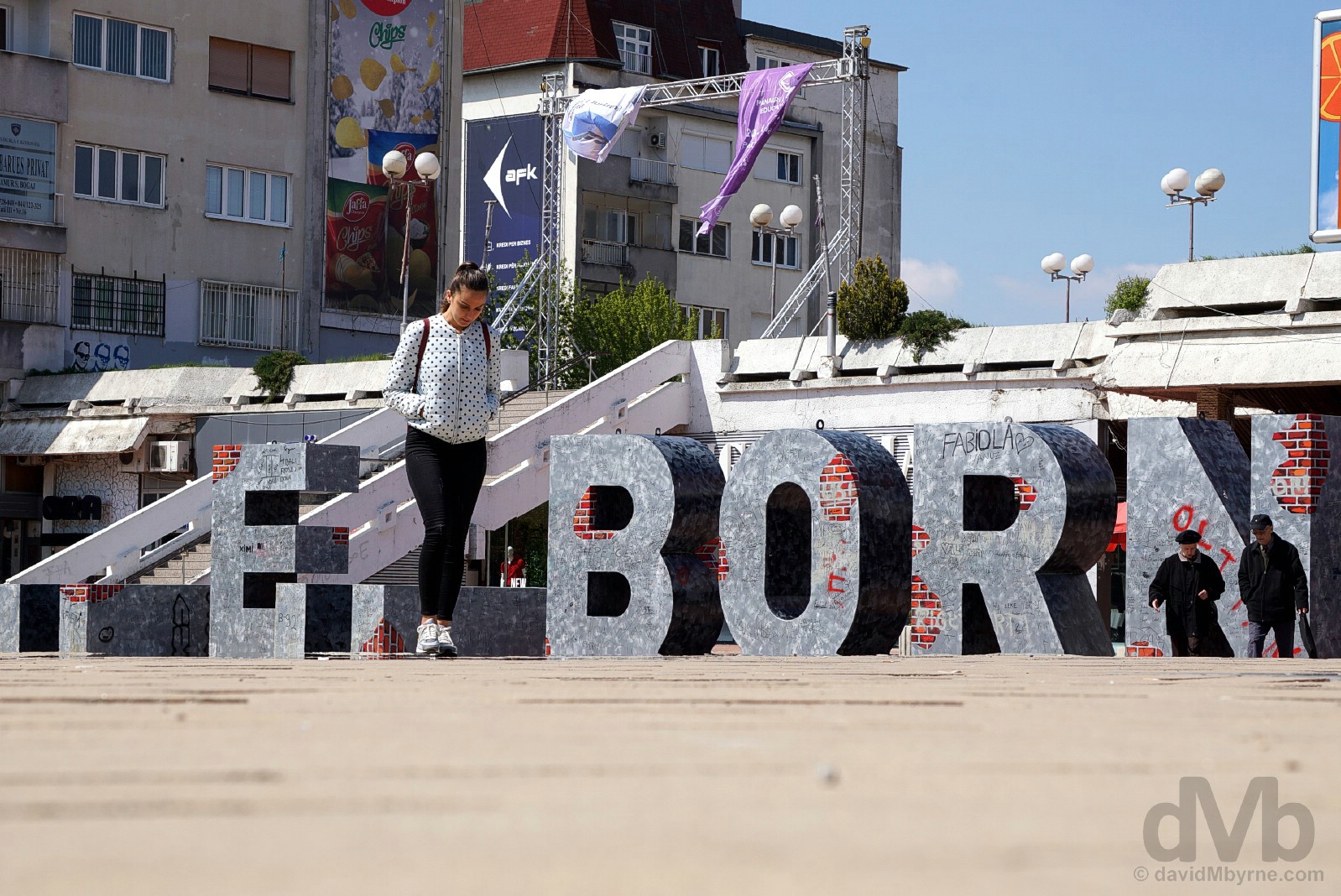
Walking past the Newborn Monument in Pristina, unveiled on February 17 2008 in celebration Kosovo’s declaration of independence proclaimed earlier that day and today a symbol of the young nation’s brighter future. Pristina, Kosovo. April 22, 2017.
Day 1
It was an early Kosovo start, the overnight bus ending its slow 300 kilometre journey across the snow-clogged passes of Prokletije (which roughly translates to ‘cursed mountains’ and which is otherwise known as the Albanian Alps) from the Montenegrin capital of Podgorica in the west depositing me into Kosovo bus station at 4 a.m. There wasn’t a whole lot stirring at that ungodly hour, so I didn’t either, opting to pass a few hours in a smoky bus station cafe, one bereft of coffee, before orientating myself and navigating my way into central Pristina.
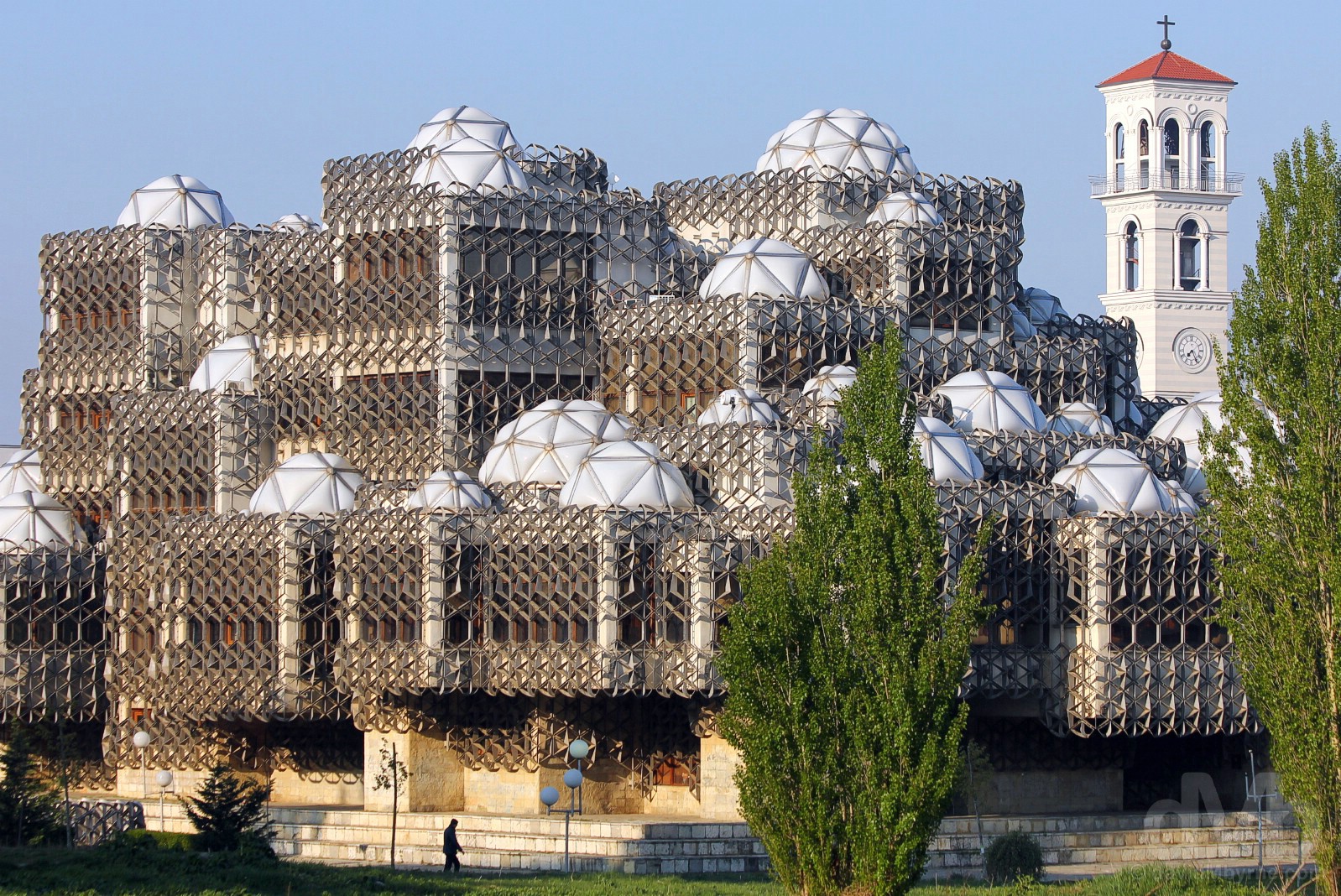
NATIONAL LIBRARY OF KOSOVO & THE CATHEDRAL OF SAINT MOTHER TERESA || Early morning by the National Library of Kosovo, Pristina, Kosovo. April 22, 2017.
It was just after 7 a.m. and even the soft light of a rising sun did little to help the appearance of the confused-looking jumble of cubes, metal netting, glass and 99 translucent, bouncy-looking skylight domes that is Pristina’s National Library of Kosovo. The eye-catching city landmark was designed by Croatian architect Andrija Mutnjakovic, who is on record as stating that the 16,500 m² building’s appearance is a representative style blending Byzantine and Islamic architectural forms. Built in the early 1980s (it opened in 1982) and somehow surviving the February 1998 to June 1999 Kosovo War unscathed, it is surely one of the world’s most aesthetically challenged edifices, one that looks even more unsightly the closer you get to it (it’s best viewed from afar, in my humble opinion). Also seen here is the 70-metre-tall bell tower of the Romanesque Revival Cathedral of Saint Mother Teresa, a city landmark that’s so new parts of it are still under construction (and have been since its groundbreaking in 2007). Open since 2010 as a place of worship to the minority 65,000 Catholics of Kosovo (95% of Kosovars are Muslim), it is set to be officially consecrated on September 5 of this year, the 20th anniversary of the death & first anniversary of the canonisation of the ethnic Albanian (like most Kosovars) Roman Catholic nun and missionary, Saint Teresa of Calcutta (the Vatican does not currently recognise Kosovo as a sovereign state). The first house of worship dedicated anywhere in the world to Mother Teresa and designed to have twin bell towers when/if completed as designed, I hear the city views from the bell tower that does stand are awesome – I tried to access the cathedral on my second day in Pristina but found it was closed to all, both worshipers and the few tourists you find here.
There’s an unmistakable youthful exuberance in Pristina, a consequence of the young populous – 70% of Kosovo’s 2.1+ million population are under the age of 35. This creates a dynamic, fashionable and entrepreneurial culture, not to mention a vibrant cafe & buzzing nightlife scene. OK so the streets of the city can be a little unkempt, in places the infrastructure is struggling, and some of the Modernist architecture can be repetitive & thoroughly uninspiring, but a stroll around the compact city will invariably reward. It’s a fun city. Curious surprises aplenty.
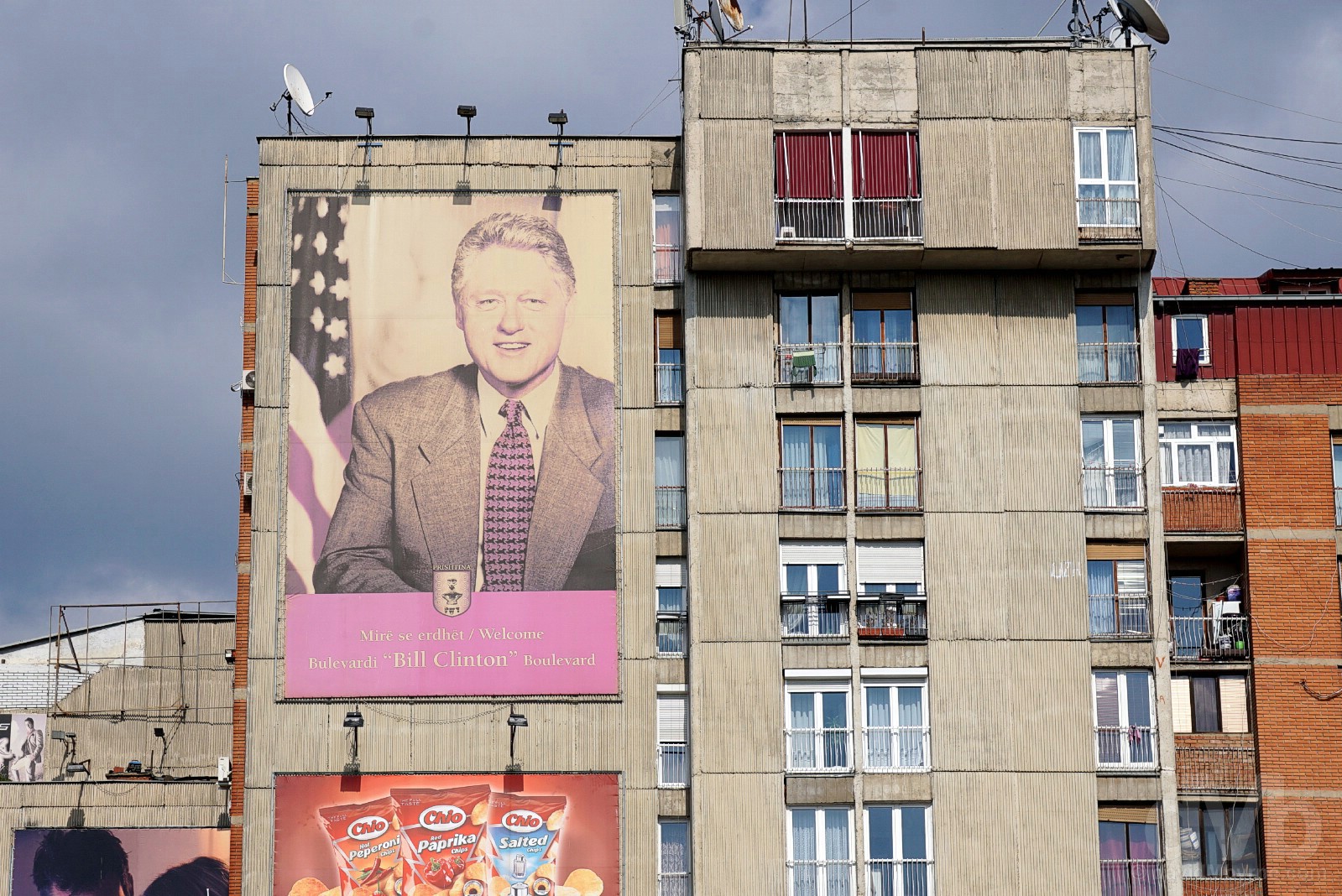
BILL CLINTON || Overlooking Bill Clinton Boulevard, Pristina, Kosovo. April 22, 2017.
I’m not sure what present-day Pristina’s Bill Clinton Boulevard was called prior to its renaming in honour of the 42nd President of the United States. There’s also a street named after former UK Prime Minister Tony Blair & former US President George HW Bush, all in recognition of NATO bombing support afforded to Kosovo during the Kosovo War and which succeeded in liberating the Albanian population of Kosovo from the oppressive FR Yugoslavia regime of Slobodan Miloševic (in what can only be regarded as a rare example of a successful western intervention in recent warring history).
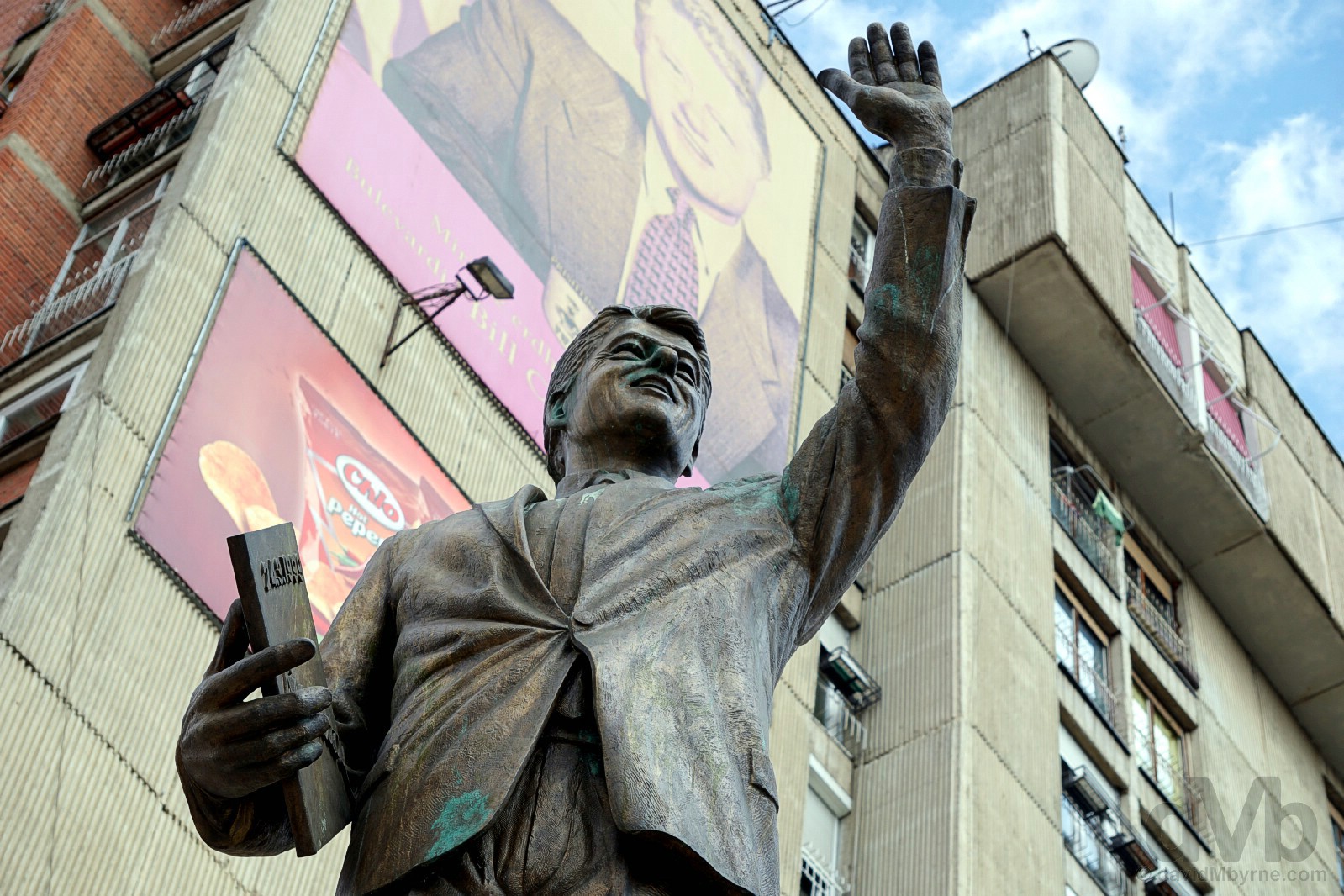
The Bill Clinton Statue on Bill Clinton Boulevard, Pristina, Kosovo. April 22, 2017.
While Bill & Tony get all the kudos today, ensuring an especially warm welcome from the hospitable Kosovars for American & British visitors, only Bill Clinton, who Kosovan Albanians hold in the highest possible esteem, is immortalised in sculpture form. Sitting atop a blocky three-tiered pedestal, the 3-metre-tall larger-than-life-size statue of a beaming Bill, his arm outstretched in welcome, was unveiled by the man himself when he visited Pristina to a rapturous reception in early November 2009.
– Bill Clinton, November 1 2009. Pristina, Kosovo.
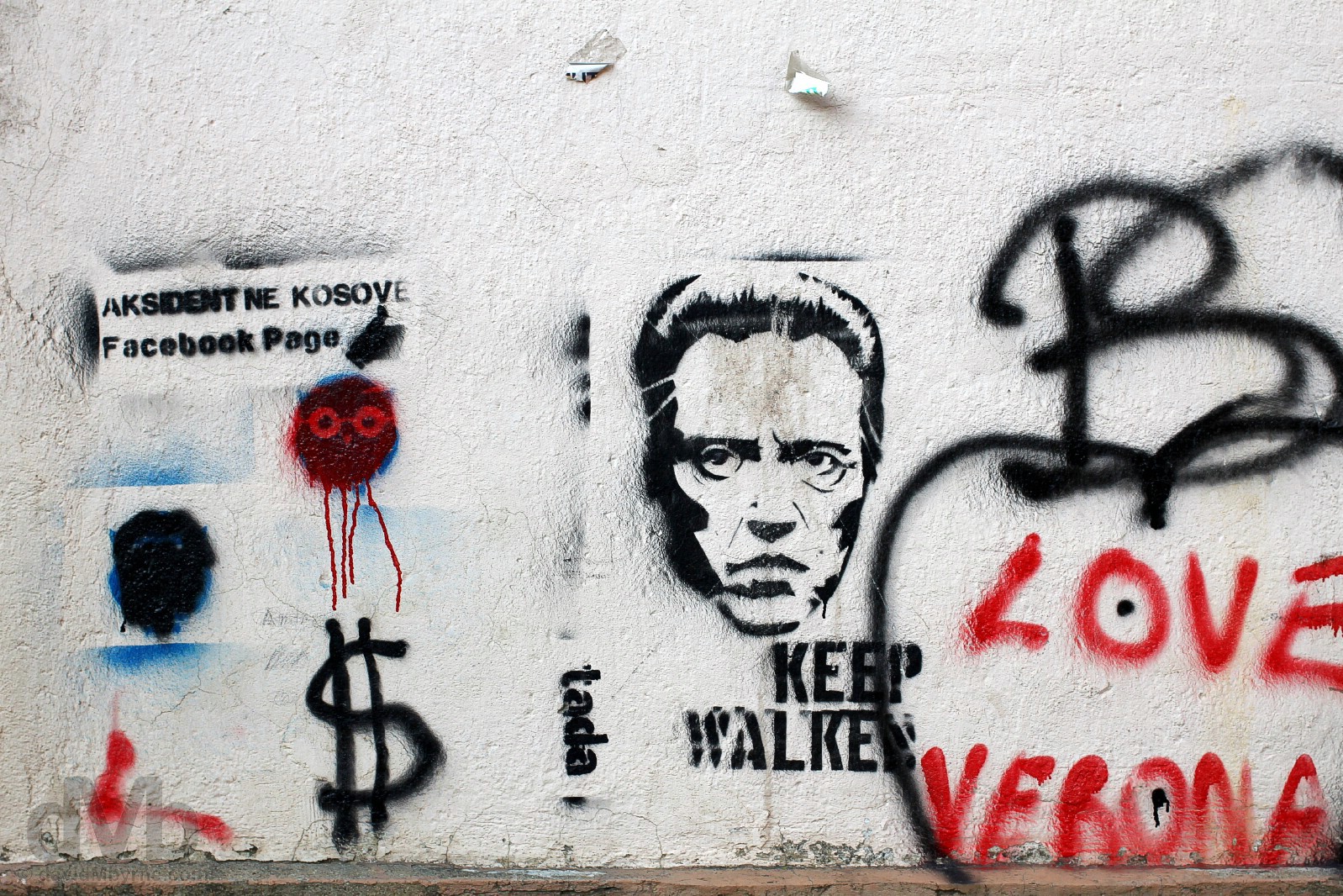
Keep Walken. I like that. On the gritty streets of Pristina, Kosovo. April 22, 2017.
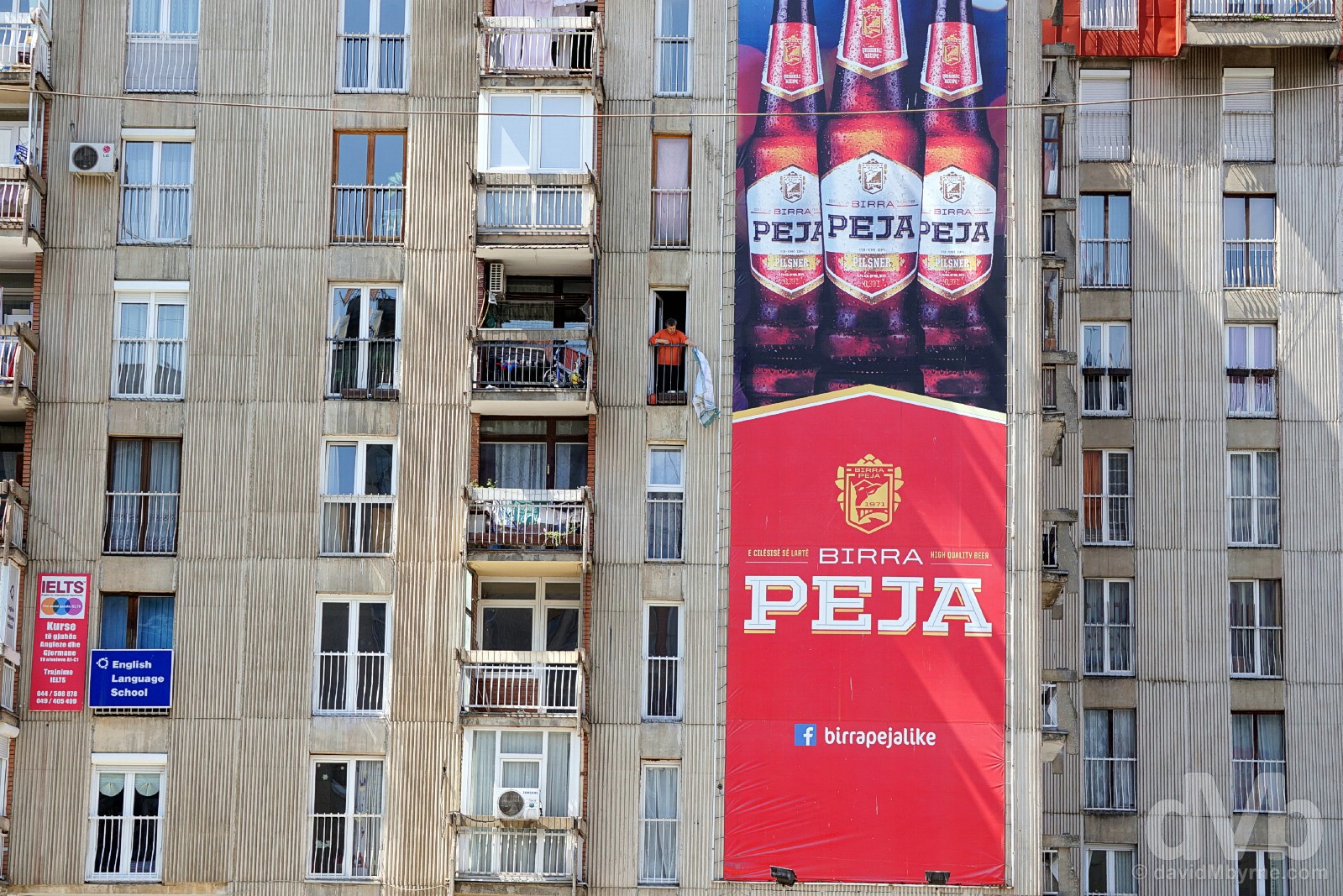
PEJA || A massive Birra Peja banner on a typical Pristina hunk of Modernist high rise reinforced concrete as seen from the streets of Pristina, Kosovo. April 22, 2017.
Brewed in Peja, 80 kilometres west of Pristina near the border with Montenegro, Peja, easily Kosovo’s favourite tipple, remains as popular today as it was during the days of the former Yugoslavia.
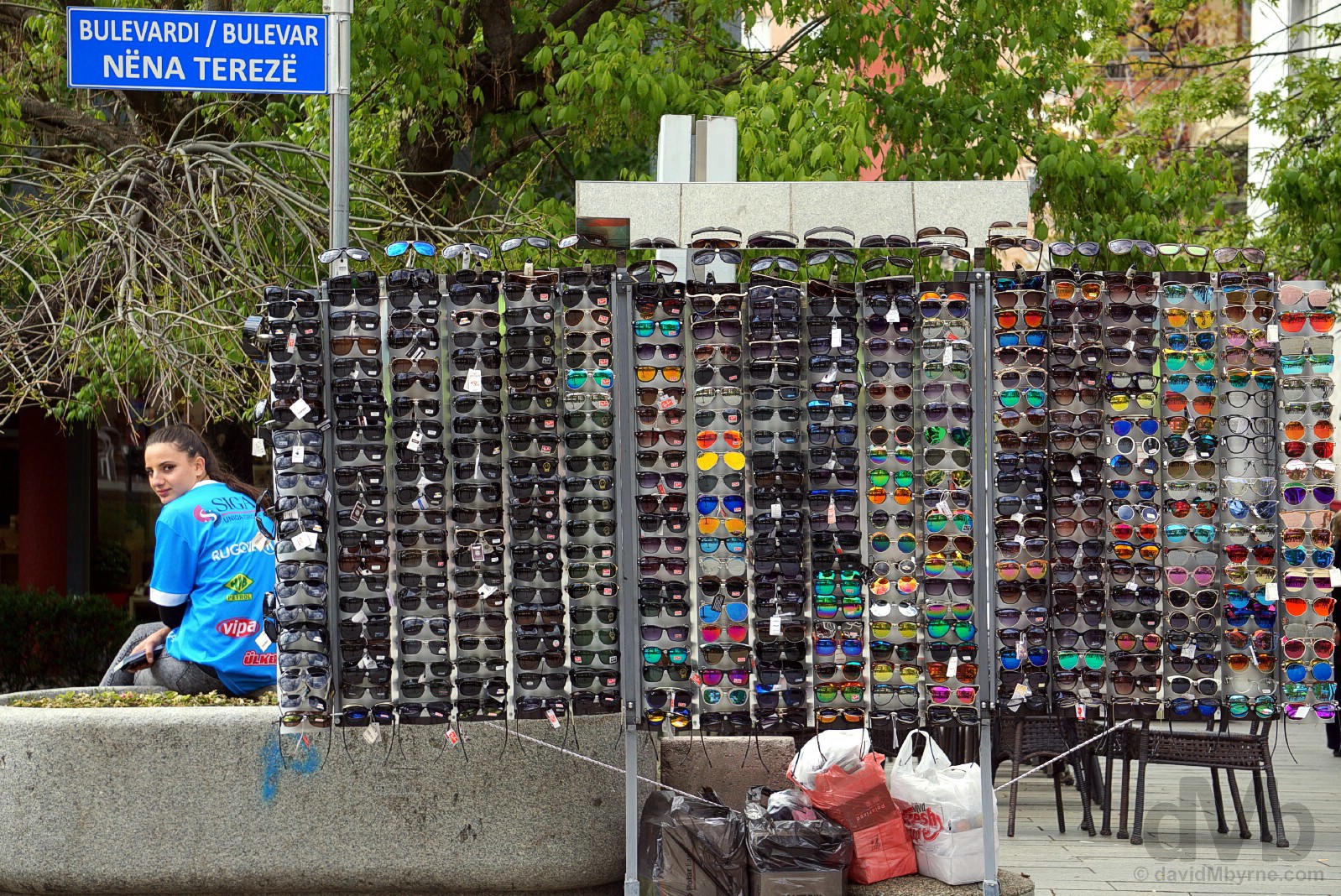
For Sale on Mother Theresa Boulevard, the city’s main pedestrian thoroughfare. Pristina, Kosovo. April 22, 2017.
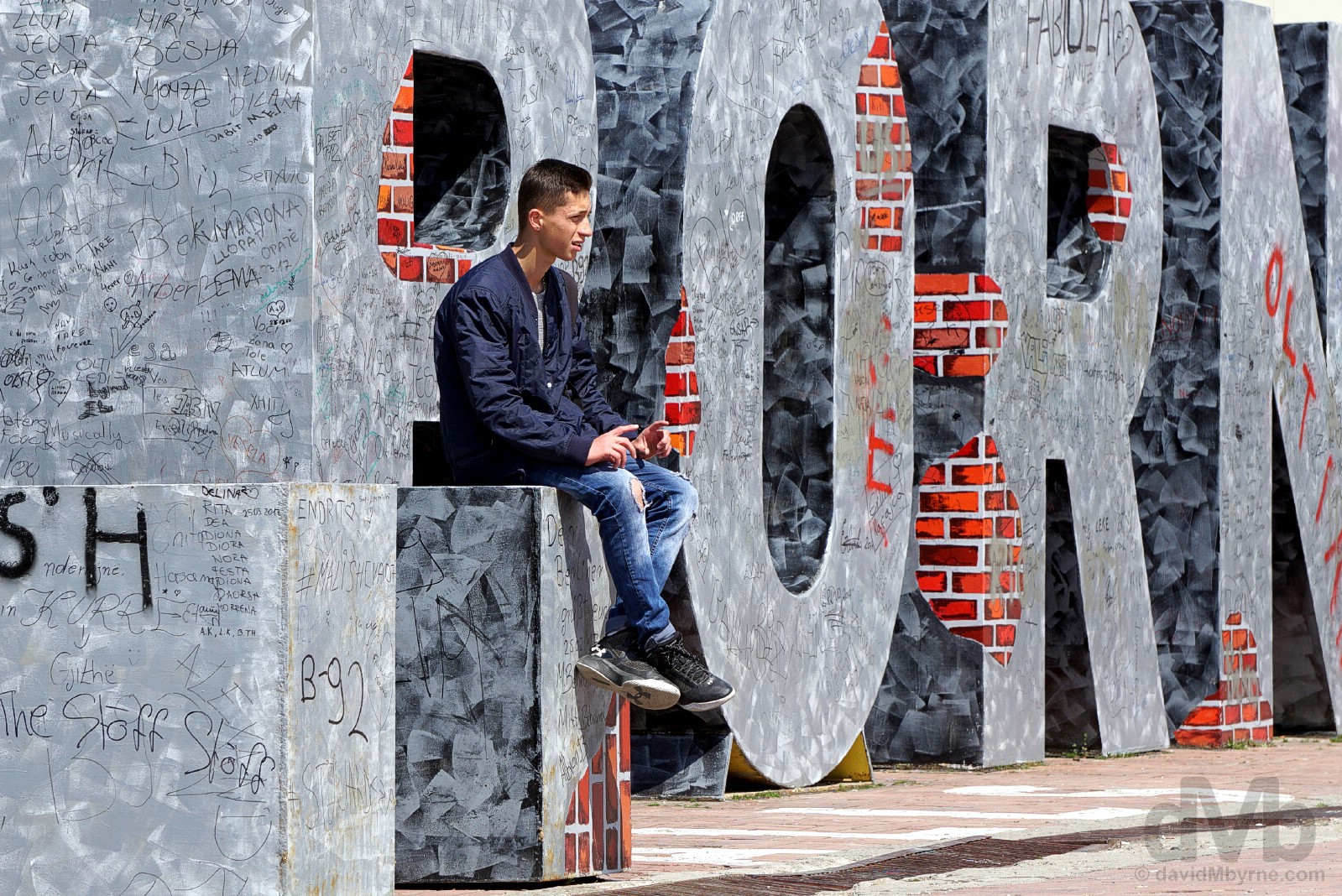
NEWBORN MONUMENT || At the Newborn Monument, Pristina, Kosovo. April 22, 2017.
Pristina’s climbable Newborn Monument is up there as the city’s go-to photo op. The large typographic sculpture is located in front of Pristina’s rather boxy Palace of Youth & Sports. Symbolising Kosovo’s optimistic outlook for the future, it was unveiled on Independence Day – February 17 2008 – and was curiously painted yellow for the first 5 years of its life. It has received a face lift every year since, different themes conveying different messages, the present one totally lost on me.
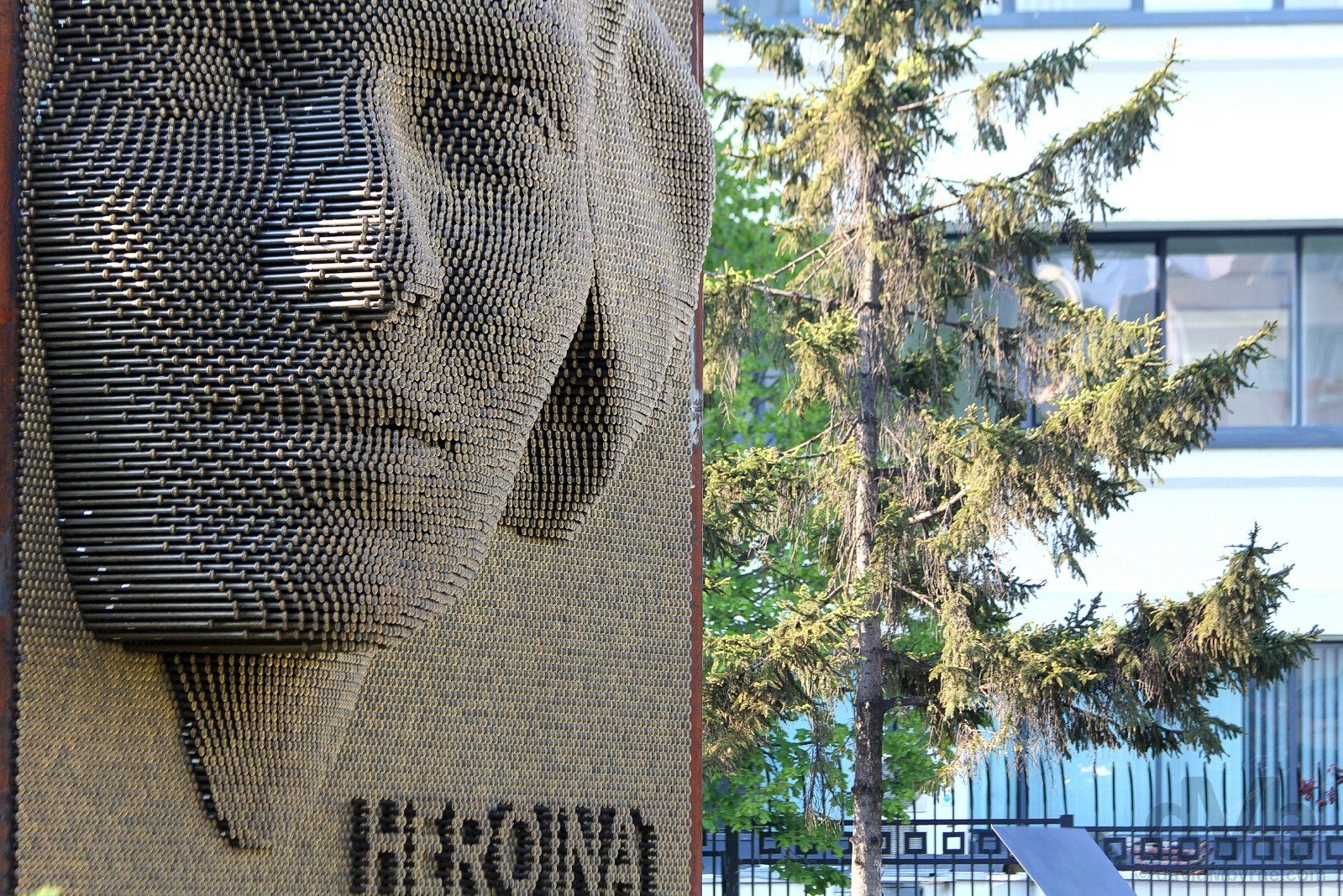
HEROINAT || Heroinat, Pristina, Kosovo. April 22, 2017.
Directly across the road from the Newborn Monument, Pristina’s sobering Heroinat (the Albanian female plural of heroes), is an award-winning memorial that honours the sacrifice of the estimated 20,000 ethnic Albanian women raped during the 1998-1999 Kosovo War. The first monument in the country highlighting the sacrifice made by women during the war, each victim is represented by a medal, a portrait of the face of the so-called heroine of Kosovo, atop a bar of varying lengths that combine to form a large-scale representation of the same heroine portrait. An awesome sight, this was just one of those unexpected finds I encountered on my ambles around the streets of Pristina.
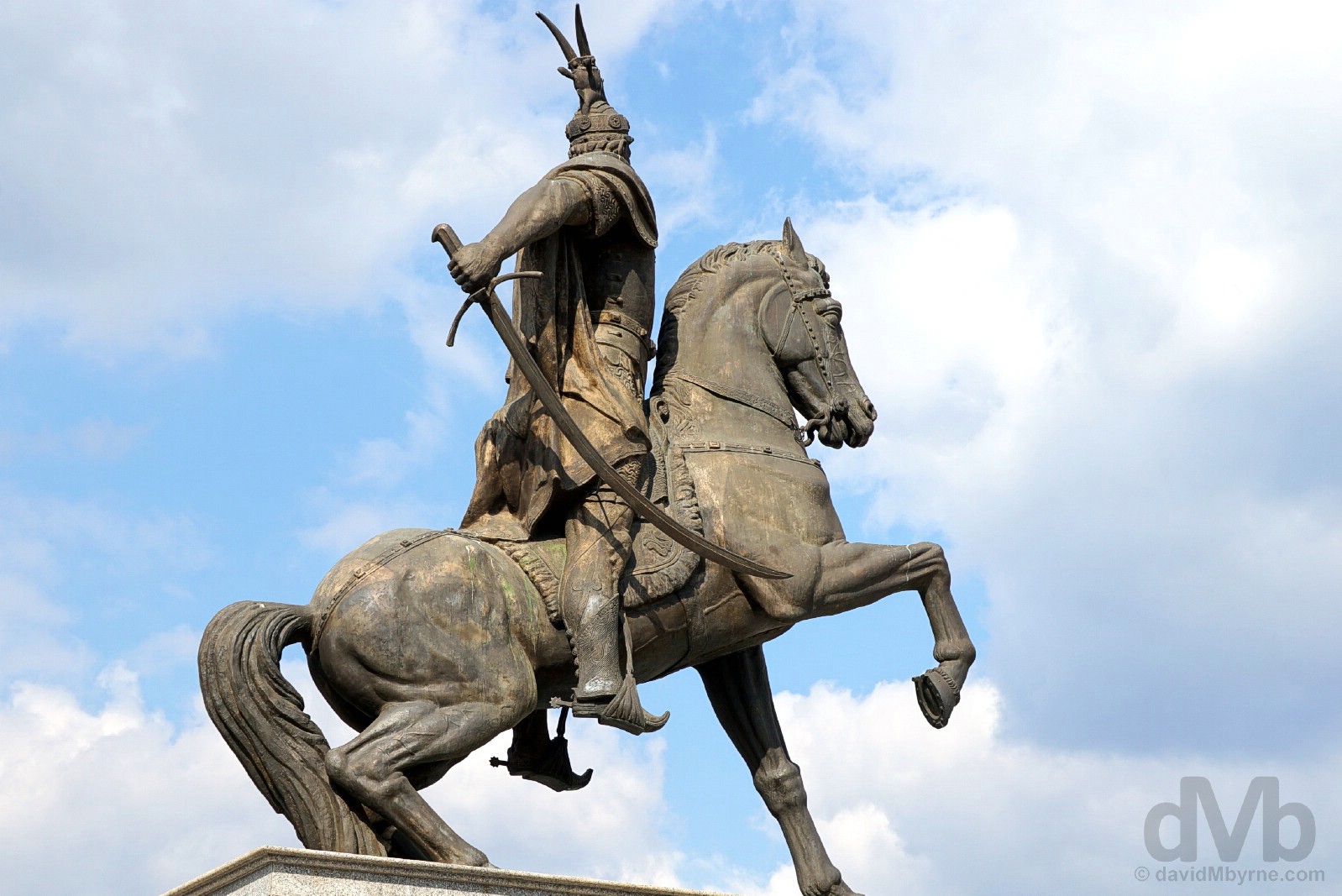
SKANDERBEG || The Skanderbeg statue, Skenderbeu Square, Pristina, Kosovo. April 22, 2017.
There had to be a Skanderbeg statue around here somewhere, somewhere being Skenderbeu Square in central Pristina. Erected on 28 November 2001, Albanian National Day, it’s a mounted statue of Gjergj Kastrioti Skënderbeu, a.k.a. Skanderbeg, the medieval Albanian leader and prominent national hero who fought to resist the Ottoman Empire during the fifteenth century. It’s the Pristina version of a similar statue that sits pride of place in the centre of Skanderbeg Square in Tirana, Albania, somewhere that confounded me almost a decade earlier.
Kosovo is petite. Not tiny mind, just under 11,000 km² small. Distances are short, and even though it’s still a 30-minute bus ride out of the city (& a 30 minute brisk uphill walk from where the bus drops you off by the side of the M25-2), the Kosovo Bear Sanctuary still amends the word ‘Prishtina’ (written the Albanian way, with a ‘h’) to its name. I left the city for the afternoon to visit the sanctuary and the nearby UNESCO-listed monastery in Gracanica, logistically doable even via slow public transport given the short distances involved.
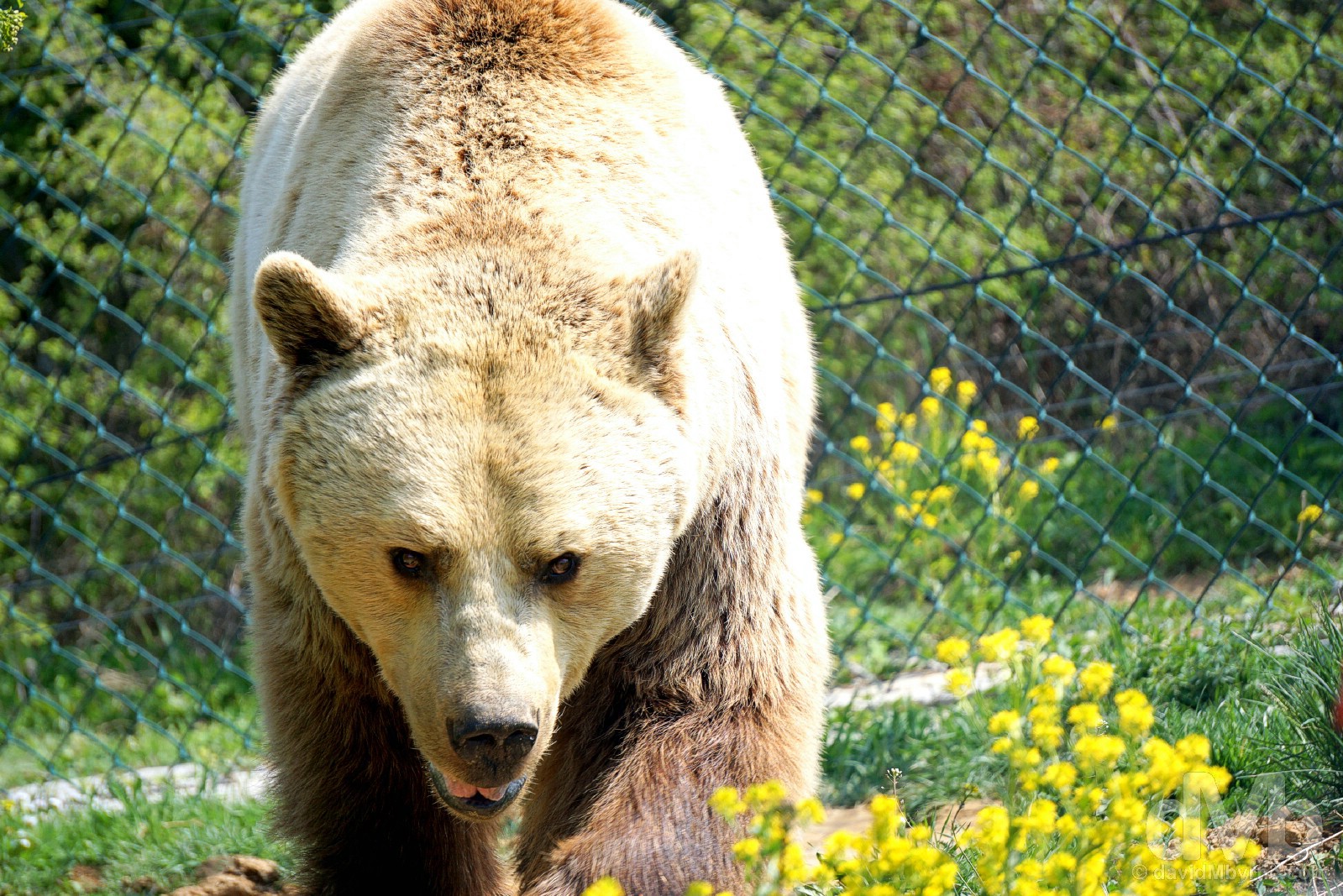
BEAR SANCTUARY PRISHTINA || A resident brown bear in the Bear Sanctuary Prishtina, Kosovo. April 22, 2017.
An absence of laws regarding the keeping of brown bears in Kosovo, born in regional forests and snatched from their mothers by animal dealers, saw bears in the past living miserable existences in small cages in restaurants as a means of attracting customers. The inevitable outlawing of private bear ownership in late 2010 was the impetus for the creation of the Bear Sanctuary Prishtina, a 16-hectare refuge for rescued ‘restaurant bears’ on hilly woodland about 20 kilometres outside Pristina and fast becoming one of Kosovo’s must-sees. Administered by the group Four Paws, an international animal welfare organisation founded in Austria in 1998, the sanctuary is home to about 15 bears unable to be released into the wild given their dependency on humans for food, their natural instincts to fend for themselves cruelly taken from them along with their freedom.

Bear Sanctuary Prishtina, Kosovo. April 22, 2017.
Brown bears live for about 25 years in the wild. In captivity, and with a good diet & proper health care, they can live well into their 40s (the oldest known brown bear in captivity died aged 47). It’s doubtful they’d have lived into old age while enduring the conditions they regularly had to endure prior to the their rescuing by the sanctuary, where gut-wrenching images of their past hardships are on display for all to see.
With a long-standing tradition of Christianity in Kosovo, there remains today many Orthodox monuments of importance throughout the country (& in the wider region). However, it’s the country’s four Serbian Orthodox church complexes – three monasteries in the towns of Gracanica, Peja and Decani, & the Church of Our Lady of Ljeviš in the city of Prizren – that get most of the attention, especially given their collective UNESCO World Heritage-listed status as the Medieval Monuments in Kosovo.
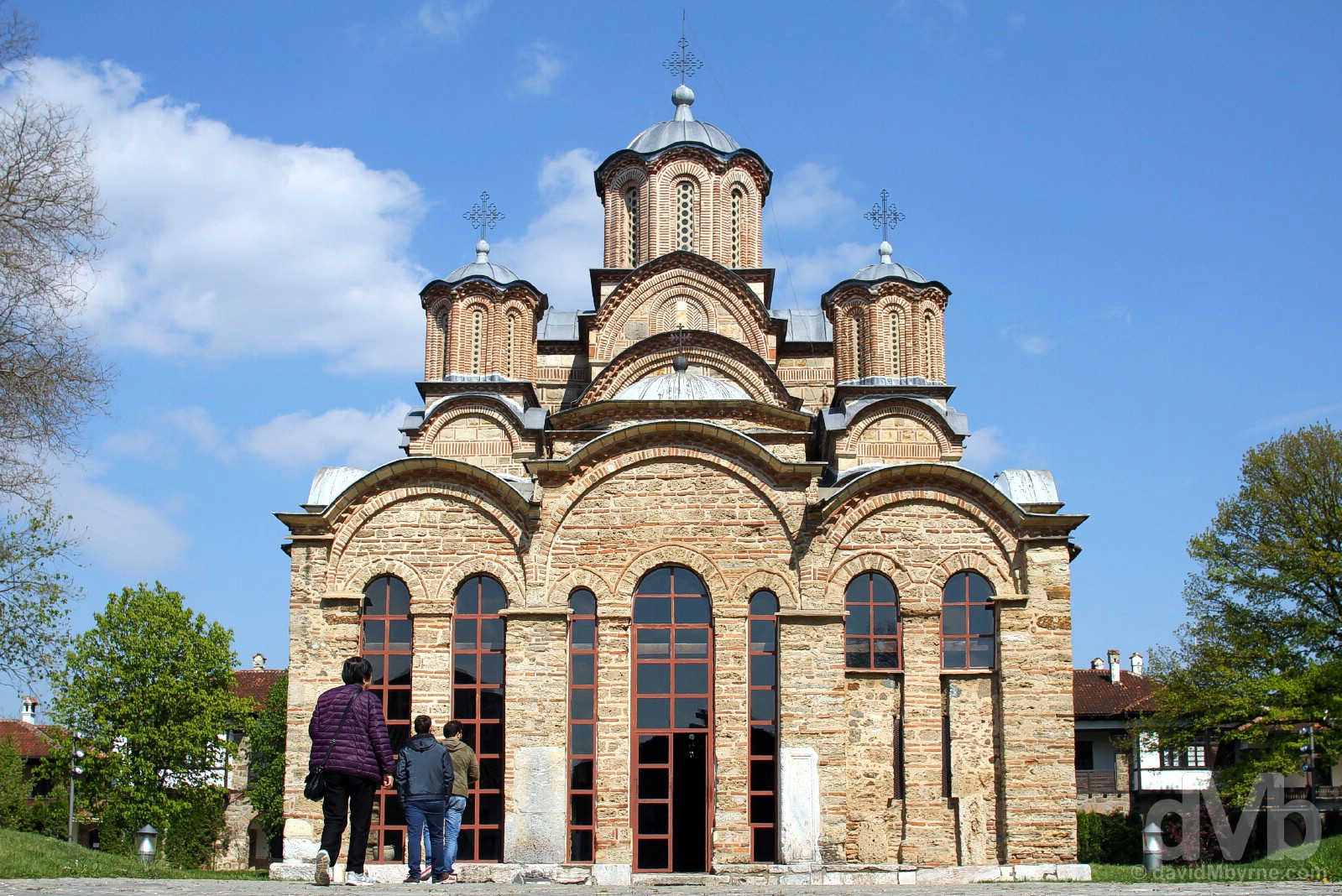
GRACANICA MONASTERY || In the grounds of the UNESCO-listed Gracanica Monastery, Gracanica, Kosovo. April 22, 2017.
The monastery of the Serbian Orthodox Church in the town of Gracanica, only 10 kilometres south of downtown Pristina, is noted as being the only one of Kosovo’s 4 UNESCO-listed structures located in an urban setting. It was built in 1321/1322 by Serbian king Stefan Uroš II Milutin and is dedicated to the Assumption of the Holy Virgin Mary. Built on top of an older Christian basilica, this cross-shaped monastery with five domes exhibits a mix of Byzantine and Gothic elements and is one of the region’s most beautiful examples of Serbian medieval ecclesiastical architecture. However, and as impressive as the exterior is, the highlight of any visit here is invariably the amazing array of richly decorated 14th & 15th century frescoes that adorn its interior, where photography is not allowed (it’s a tough place to be when prohibited from using a camera).
– UNESCO commenting on the Medieval Monuments in Kosovo
Day 2
Day 2 in Kosovo was a wet affair, the sunny skies of the previous day nowhere to be seen. I took shelter where I could find it, mostly in Pristina’s Ethnological Museum and under the tarps covering the lanes of its atmospheric Green Market, both located in the city’s not-so-old Old Quarter.
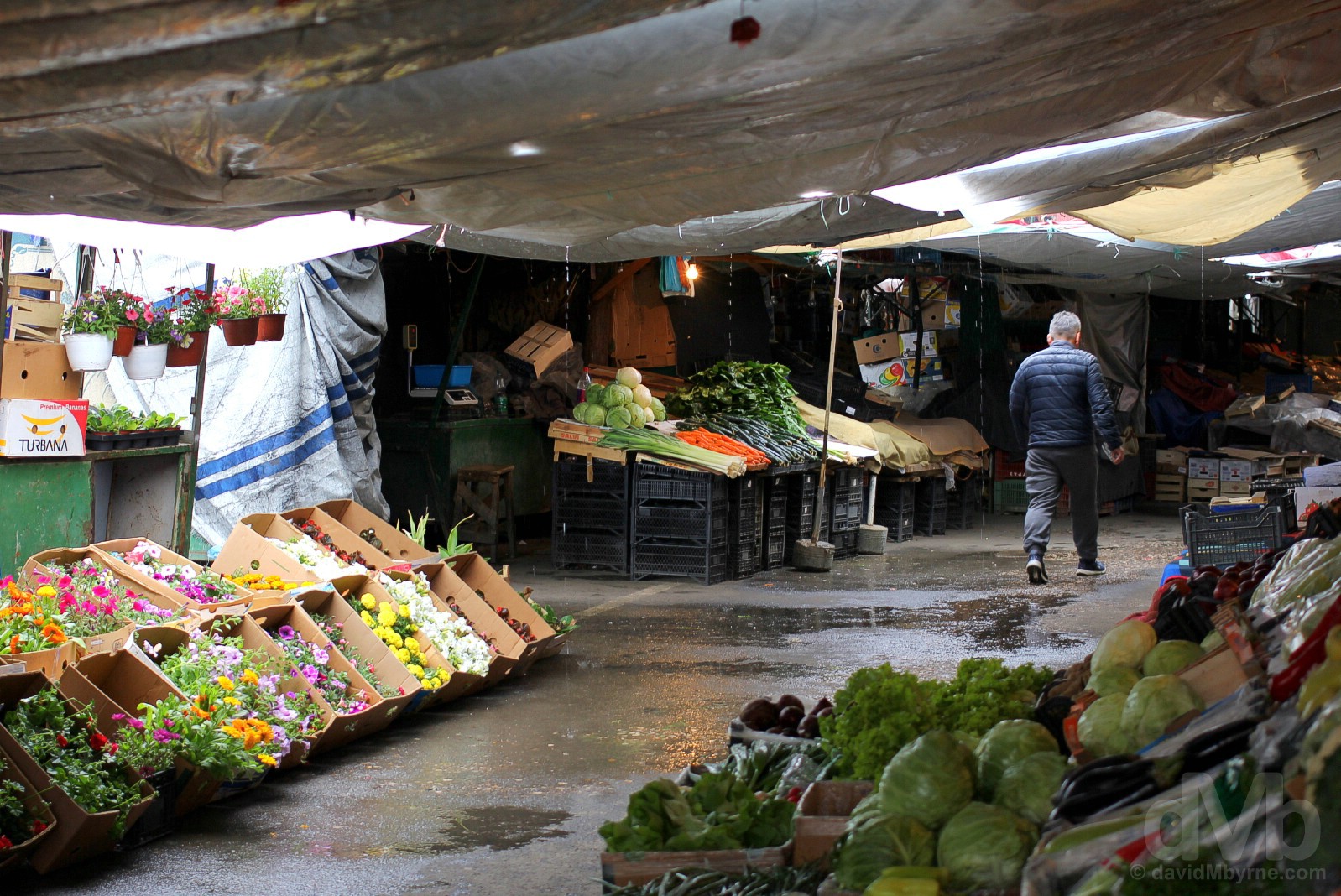
Sheltering from the rain under the tarps in a covered section of Green Market, Old Quarter, Pristina, Kosovo. April 23, 2017.
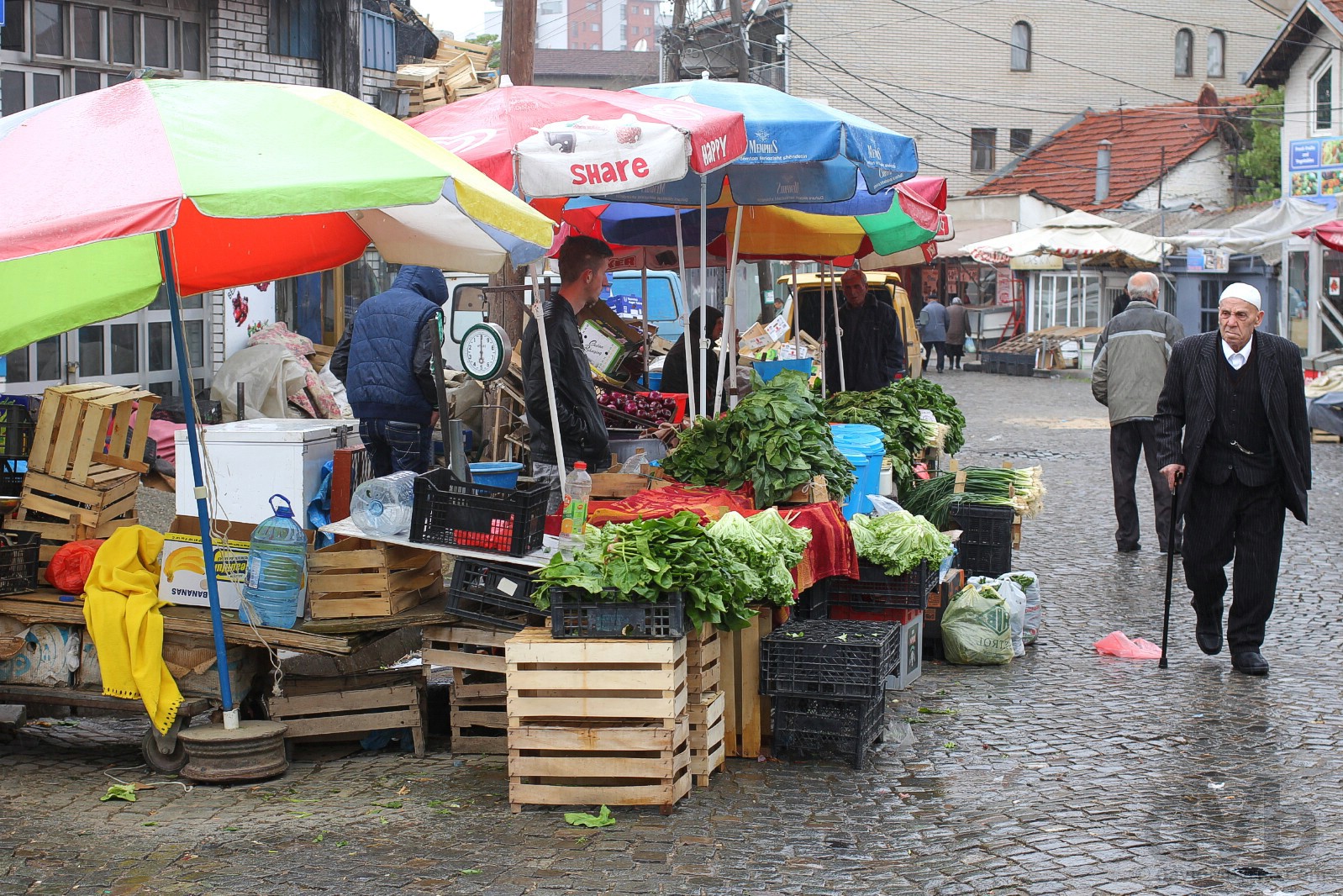
OLD QUARTER/OLD BAZAAR/GREEN MARKET || Green Market, Old Quarter, Pristina, Kosovo. April 23, 2017.
Unfortunately the Old Quarter of Pristina is not as old as one might imagine. There’s nothing left of the city’s original 15th century Bazaar, the majority of it razed as a result of ‘Destroy the old, build the new’ modernisation schemes of the communist-era 50s & 60s (along with a swath of Old Pristina churches, synagogues and mosques). Once the centre of the city and the core of the merchandising hub of Ottoman-era Pristina, the bazaar was a hub for tradesmen and specialised craftsmen who played a significant role in the physical, economic and social development of the city. Today, and with all remnants of the ancient past gone, the city’s Green Market is a haphazard mixture of covered narrow market lanes and primitive open stalls spilling out onto the surrounding streets. It’s far from pretty and often hectic, meaning it’s a great place to explore and interact with the friendly locals.
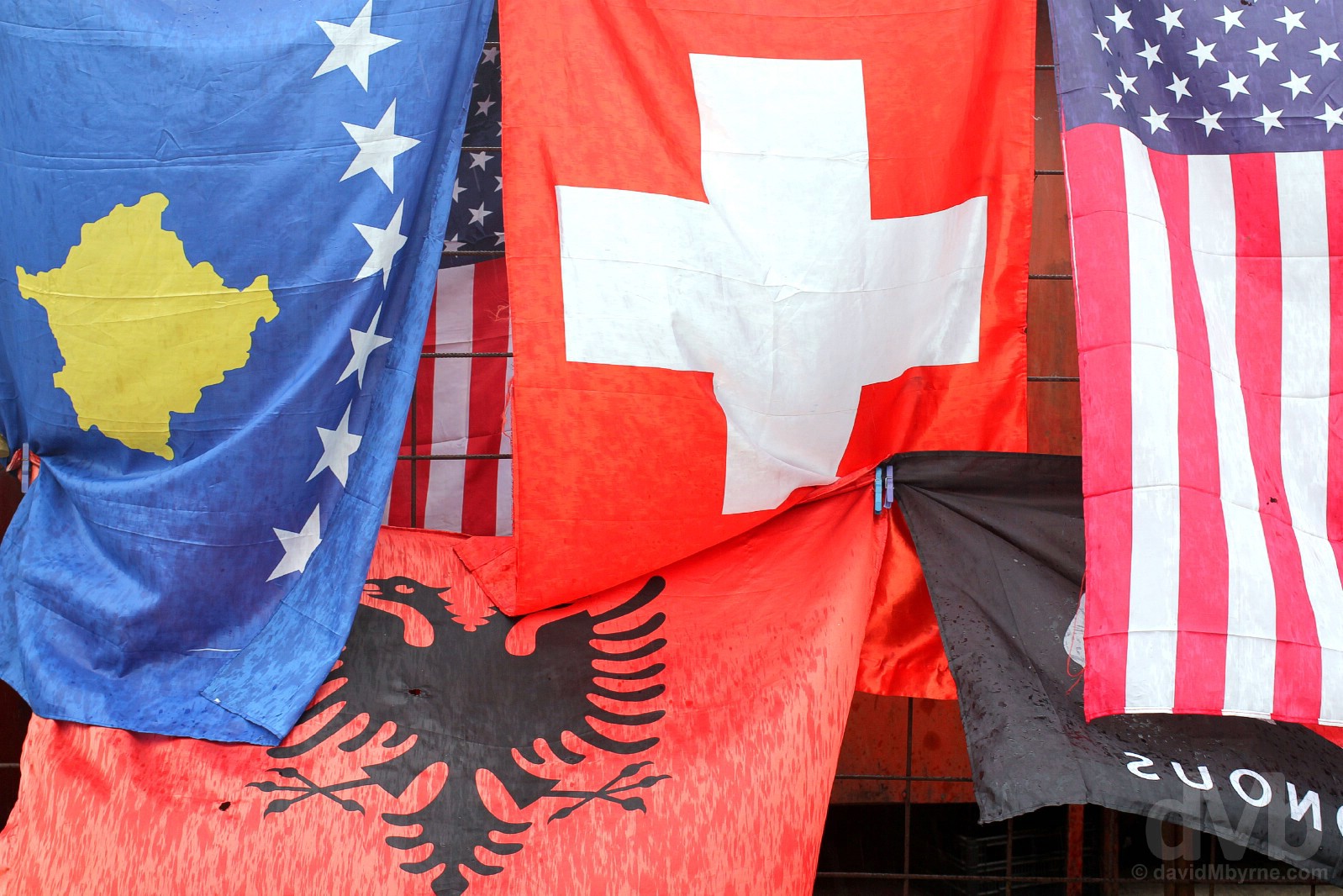
Friends. The Kosovan, Swiss, Albanian & US flags fluttering in the rain of a wet Green Market, Old Quarter, Pristina, Kosovo. April 23, 2017.
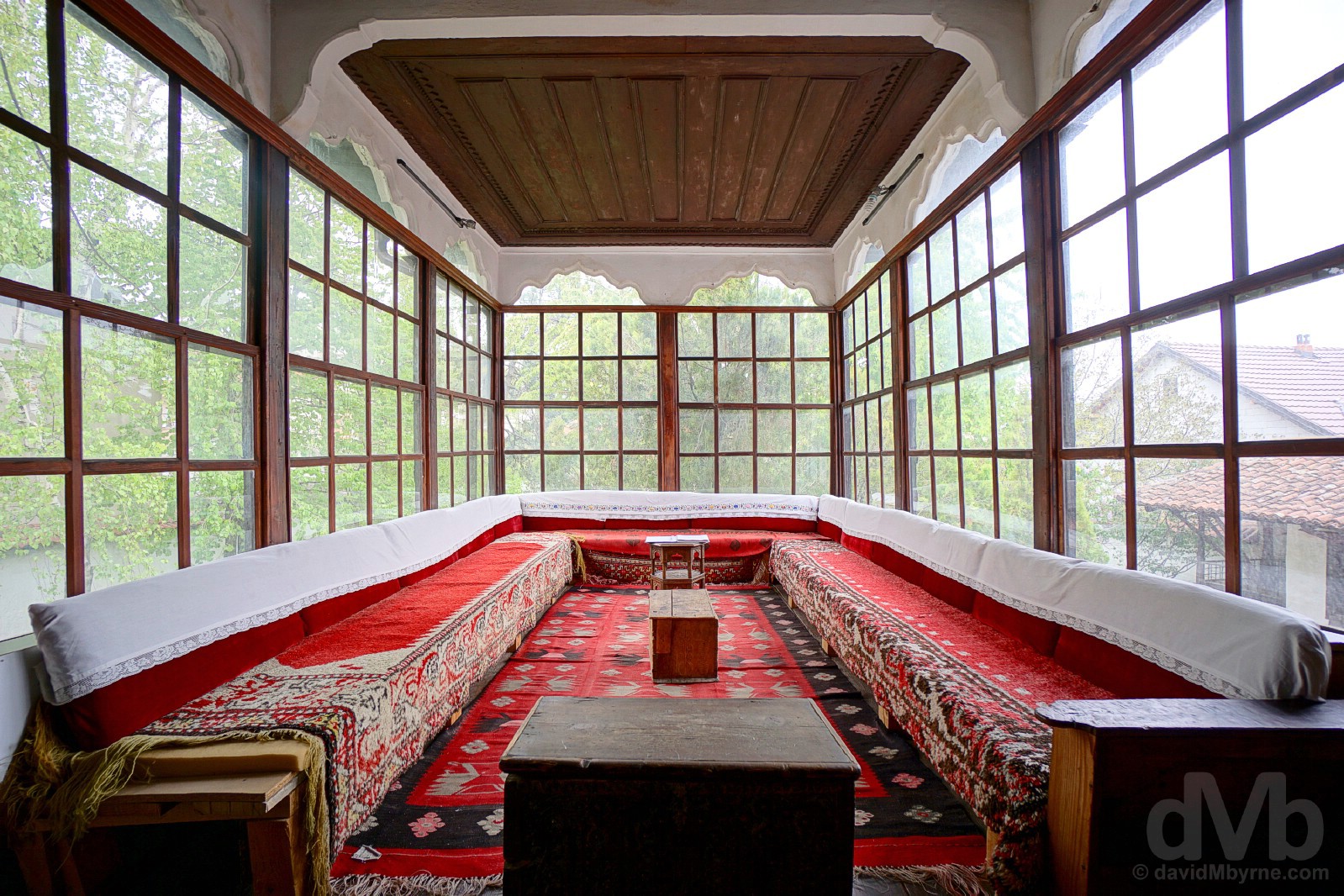
ETHNOLOGICAL MUSEUM || The Ethnological Museum, Pristina, Kosovo. April 23, 2017.
Pristina’s Emin Gjiku Complex, a small grouping of 18th century, Ottoman-era residential buildings beyond the lanes of Green Market in the city’s Old Quarter (follow the signs), is the location for the interesting Ethnological Museum, displaying all manner of items – clothing & textiles, tools, utensils, jewellery, musical instruments, pottery, period furniture & weapons, etc. – from the Ottoman Kosovo period in a bid to tell the story of the Ottoman rule in Kosovo from the 15th century through to the 20th century. Creatively curated & certainly worth a visit, I found the two creaking buildings themselves, beautifully preserved and presented thanks to a 2003 internationally funded conservation effort, more interesting than the artefacts they house.
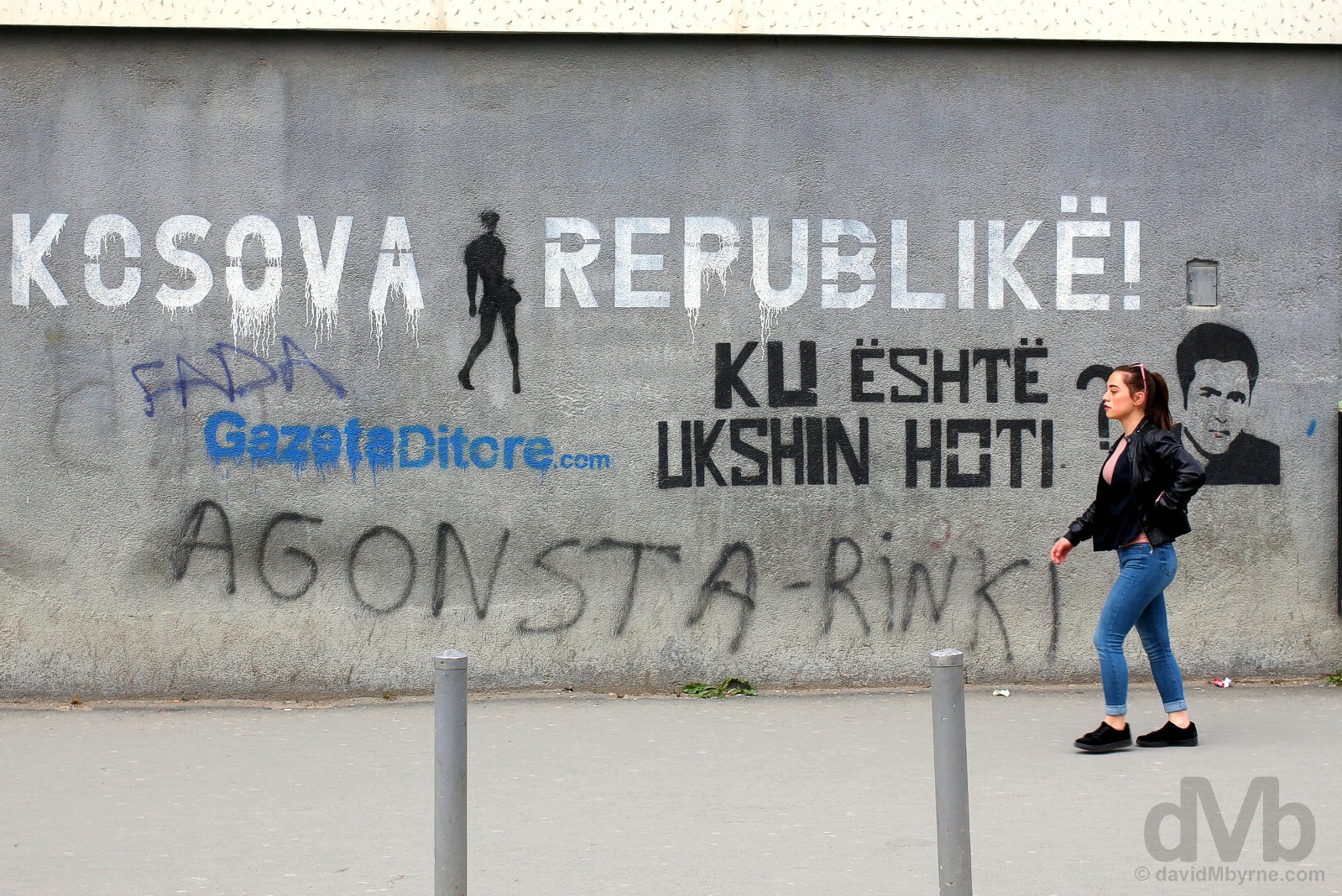
Street. A parting shot from the streets of Pristina, Kosovo. April 23, 2017.
Signing Off | The Complete Kosovo Gallery


